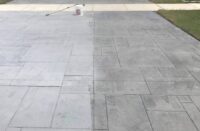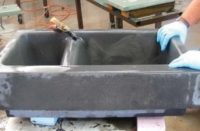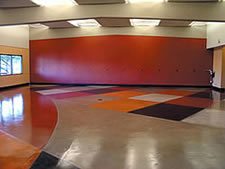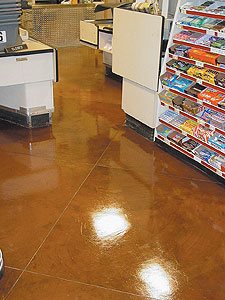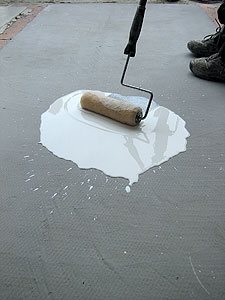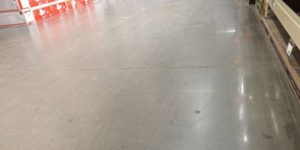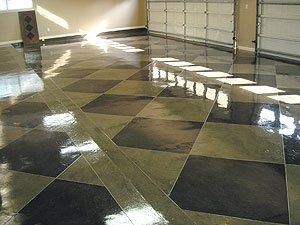 Decorative concrete deserves to be protected. After you’ve put in all that hard work, creative effort and time, you — and your client — should expect that beauty to last a while. And it can, if you seal it properly.
Decorative concrete deserves to be protected. After you’ve put in all that hard work, creative effort and time, you — and your client — should expect that beauty to last a while. And it can, if you seal it properly.
Of course, with so many products on the market these days called “concrete sealers,” it is not surprising that the topic can get a bit confusing. Chris Sullivan, national technical director of QC Construction Products, explains there are three general categories of products referred to as sealers: cures, cure-and-seals, and sealers. It’s this third category — protective sealers — we’re looking at in this discussion.
Decorative concrete sealers can be further grouped as either film-forming or penetrating sealers. Film-forming sealers, such as straight acrylics, urethanes and epoxies, provide a protective barrier on the surface of the concrete. Penetrating sealers, such as silanes, actually migrate into the surface of the concrete and generally do not affect the appearance of the surface. (For more information about types of protective sealers, see the June 2003 issue of Concrete Decor.)
However, as important as the correct selection and/or specification of a sealer may be, so is proper application.
Start with a clean surface
Having a clean surface to seal is paramount, says Mark Glendrange, technical director at Versatile Building Products Inc. “I’ve always said 90 percent of dollars and time is spent in preparation.”
Bert Adams, president of Glaze ’N Seal Products, agrees that you must have a clean, dry surface, free of any contaminants. But he cautions, “One thing people don’t always remember is that most sealers don’t like acid residue.” Be sure to neutralize the surface after cleanup if there is any question, he advises.
For new floors, surface cleaning and preparation should be pretty straightforward. But if you have a previously finished surface to which you are applying sealer, the porosity of the surface is an important factor as well, Adams says. For example, if the old floor has been sealed with a penetrating sealer in the past, you may have a problem applying a film-forming sealer. Adams tests for the presence of penetrating sealer with a few drops of water. “If the water beads up, a film-type sealer may not bond properly.” In these situations, he says, it’s important to talk to the sealer manufacturer for advice regarding necessary surface preparation to accept the new sealer.
Before applying a sealer, the surface temperature — not the air temperature — also needs to be within the parameters specified by the sealer manufacturer.
However, the most critical factor in any sealer application is the applicator — the person and the equipment. As Sullivan observes, “The biggest contributing factor to sealer failure is not using the proper equipment, and not applying correctly or [applying it] outside the recommended parameters.”
Spraying sealers
The application technique you should use for applying sealers depends on the sealer you’re using and the situation. Of course, be sure to read the manufacturer recommendations for the specific product you are using. Generally speaking, however, there are some preferences among the experts.
Pump-up, Hudson-type sprayers are the most-referenced and most-recommended spray apparatus used to apply solvent-based sealers. Some water-based and penetrating sealers can also be sprayed on. Key factors include the viscosity of the sealer and, for film-building sealers, how high a build you need; if you need a high build from a thick sealer, spraying won’t do.
When spraying, Sullivan says, the finer the tip, the better application you’ll get, with regard to consistency and minimal application. Also, “when you spray, back-rolling is a good idea,” he adds.
Silanes are very sprayable, reports Glendrange. And with penetrating sealers it’s “typically not as critical to get an even coating because it’ll penetrate.”
Spraying also helps you cover a lot of ground efficiently. Adams prefers pump-up sprayers when sealing large areas, particularly for exterior applications. Indoors, he says, in many cases you might use a sprayer, “but you have to worry about overspray, so you might use a lamb’s wool applicator or consider a paint pad.” For even, smooth surfaces, applicators are a very controlled method to apply sealers. But they don’t work so well for stamped or textured surfaces where you may need to work the sealer into stamped joints.
As an additional tip for applying sealers, Adams recommends having a natural-bristle paint brush in your back pocket to brush out any puddling that may occur as you work your way across the surface.
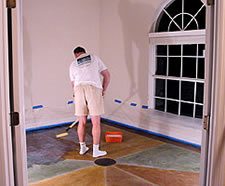 Rolling sealers
Rolling sealers
“Ninety-nine percent of sealers can be applied with a conventional paint roller,” observes Ira Goldberg, president of Beyond Concrete. “It’s also a proven method,” he adds, especially if you are adding a slip-resistant additive to your sealer for the final coat. “It won’t go through a sprayer — it has to be rolled on.”
Sullivan recommends rolling water-based sealers, though he also says thin-film sealers can be sponge or mop applied. Silanes, in addition to being sprayed on, can be rolled on effectively, too, he says.
Glendrange points out that rolling is necessary for urethanes. For larger jobs, one could squeegee and back-roll, but for smaller jobs you can dip and roll. “Some pour [the sealer] directly on the floor, but it’s more difficult to achieve an even film,” he says.
The kind of roller you use depends on the type of sealer you’re applying.
“With water-based sealers you can use any kind,” Goldberg reports. But for solvent-based sealers you want “one that the core won’t melt or be eaten by the solvent — use one that’s solvent-safe.”
According to Glendrange, lint-free rollers are best for water-based applications, as well as urethanes and epoxies. On the high end are mohair rollers, which, he adds, work the best and are the least likely to release lint. “The higher the viscosity, the more likely you are to have lint pulling out [from the roller],” Glendrange says.
Goldberg observes that “epoxy tends to pull back on the roller.” He strongly advises using special lint-free rollers when using epoxy sealers.
Some experts recommend using a squeegee to apply epoxies, then back-rolling.
The thickness of the nap of a roller depends on the texture of the substrate you’re sealing. For smooth surfaces a shorter nap — say 1/4-inch or shorter — should suffice. You’ll need to use a higher-napped roller for textured surfaces. A time-saving tip from Goldberg is to use an 18-inch roller instead of a 9-inch roller when doing a large job. “You’ll cover twice as much in the same stroke.”
Other considerations
Something all the experts seem to agree on is that multiple, thin coats of sealer is best.
“A good rule of thumb is ‘thin to win,’” says Sullivan.
“Film-forming sealers have to be applied more carefully; you need even, continuous film,” explains Adams. And multiple thin coats gives you added control.
Glendrange agrees. “Two coats are always better than one, no matter what system you’re using.” Multiple coats help ensure you fill any voids that may have occurred in the first coat. But be aware of the recoat time recommended by the manufacturer. “For example, urethanes are more difficult to recoat than epoxies,” he says.
On the other hand, penetrating sealers are less demanding. You need to apply enough to soak into the surface, so these sealers are often applied liberally.
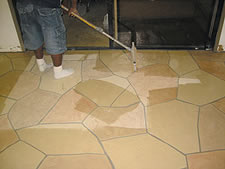 Also, be aware of environmental conditions when applying sealers. Direct sunlight, high heat or cool temperatures, and windy conditions can all impact the application. For example: The set-up time of solvent-based sealers can be accelerated by wind and warm temperatures. “If the solvents flash off too fast there’s not enough time for the acrylic to penetrate,” Adams explains. “Instead it sits on the surface and you don’t have a good bond, which may lead to sealer failure in the future.”
Also, be aware of environmental conditions when applying sealers. Direct sunlight, high heat or cool temperatures, and windy conditions can all impact the application. For example: The set-up time of solvent-based sealers can be accelerated by wind and warm temperatures. “If the solvents flash off too fast there’s not enough time for the acrylic to penetrate,” Adams explains. “Instead it sits on the surface and you don’t have a good bond, which may lead to sealer failure in the future.”
How temperatures affect cure times is almost a science in itself, says Glendrange. Moisture in the air also may be a very important consideration. For example, “moisture-cure urethanes require moisture to cure, so dry climates can prevent the necessary chemical reactions they require.”
With penetrating sealers you have a little more flexibility, but temperatures and the environment are important considerations with all sealers.
In choosing a sealer, your decision will likely be based on the desired aesthetics and the protection you need. But in applying a sealer, the specific criteria of the job — indoors or outdoors, smooth or textured surface, film-forming or penetrating sealer, and water-based or solvent-based — will dictate the proper equipment and application method.
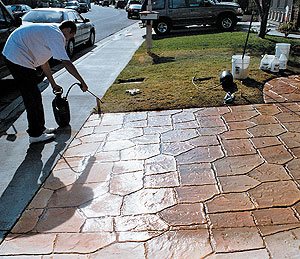 “If you are working with sealers for the first time or don’t use them frequently, read the product directions carefully and do a test patch to verify you get the kind of look and protection you anticipate,” cautions Adams. It will also help you determine the most efficient technique for application before you tackle the whole project.
“If you are working with sealers for the first time or don’t use them frequently, read the product directions carefully and do a test patch to verify you get the kind of look and protection you anticipate,” cautions Adams. It will also help you determine the most efficient technique for application before you tackle the whole project.
At the end of the day, Sullivan says, sealers aren’t anything to be afraid of, but they do need to be maintained. “It is key to their longevity and in keeping them looking good,” he says.
If in doubt, ask questions. As Glendrange points out, “When a manufacturer has a chemist on staff, it’s advantageous for the contractor to take advantage of that expertise.
